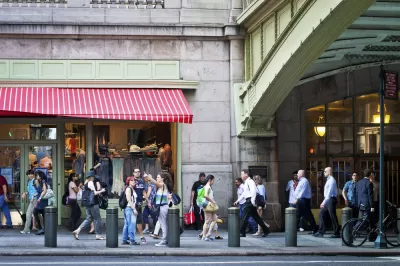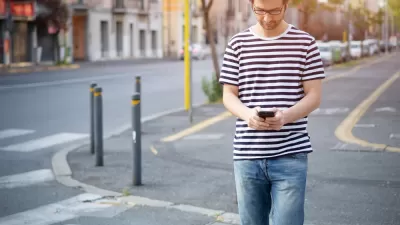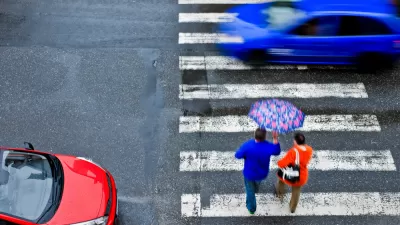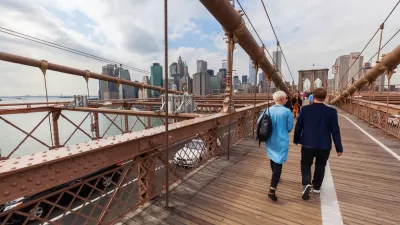New York City has come a long way since the Giuliani days, when sidewalk barriers were placed at intersections to facilitate turning vehicles, thus prohibiting pedestrians from crossing the street.

A bill by city councilman Ydanis Rodriguez "is about reclaiming space for pedestrians and giving them priority over cars," reports Vincent Barone, who covers transportation for amNewYork. It would further the goal of Vision Zero to eliminate traffic deaths and injuries on city streets.,
The legislation...would require the city’s Department of Transportation to study and identify the 10 locations with the highest pedestrian volume in the city and develop strategies to improve safety and traffic flow for pedestrians.
“In this city, most New Yorkers rely on public transportation — and we also walk,” said Rodriguez, chair of the Transportation Committee. “It’s important that this is a starting point to look for opportunities to make sidewalks more walkable and safer and make sure the DOT has the data to make that possible.”
A June 30 New York Times piece (posted here by Philip Rojc, contributing editor at Planetizen), described Manhattan sidewalks so crowded that pedestrians had resorted to walking in the streets, despite the danger posed by motor vehicles.
“Immediately what comes to mind is Seventh Avenue in midtown where we see pedestrians having to walk into the street to get to major transportation hubs,” said Caroline Samponaro, deputy director of Transportation Alternatives. “This sounds like a promising start to address that.”
Support for the bill goes beyond groups that advocate for pedestrians to those who support economic development in Manhattan.
Tim Tompkins, president of the Times Square Alliance and supporter of the legislation, said that from the Crossroads of the World [not to be confused with "America's first outdoor shopping mall" in Los Angeles] he’s noticed a shift in governmental approach to supporting pedestrian growth.
“In the past 10 or 15 years, we’ve seen this focus on pedestrians, which is a way in which the city is evolving positively, whether that’s on 42nd Street or Flushing Avenue.” Tompkins said.
In December 1997, the Giuliani administration undertook "an experiment to ease vehicular gridlock in midtown by blocking off pedestrian crosswalks," reported Andy Newman for The New York Times.
Also on Planetizen:
-
Crowded NYC Sidewalks Force Commuters Into the Street, July 7, 2016
-
New York City's Sidewalk Shed Epidemic, February 8, 2016
FULL STORY: Bill aims to improve NYC’s most congested sidewalks

Alabama: Trump Terminates Settlements for Black Communities Harmed By Raw Sewage
Trump deemed the landmark civil rights agreement “illegal DEI and environmental justice policy.”

Planetizen Federal Action Tracker
A weekly monitor of how Trump’s orders and actions are impacting planners and planning in America.

Why Should We Subsidize Public Transportation?
Many public transit agencies face financial stress due to rising costs, declining fare revenue, and declining subsidies. Transit advocates must provide a strong business case for increasing public transit funding.

Understanding Road Diets
An explainer from Momentum highlights the advantages of reducing vehicle lanes in favor of more bike, transit, and pedestrian infrastructure.

New California Law Regulates Warehouse Pollution
A new law tightens building and emissions regulations for large distribution warehouses to mitigate air pollution and traffic in surrounding communities.

Phoenix Announces Opening Date for Light Rail Extension
The South Central extension will connect South Phoenix to downtown and other major hubs starting on June 7.
Urban Design for Planners 1: Software Tools
This six-course series explores essential urban design concepts using open source software and equips planners with the tools they need to participate fully in the urban design process.
Planning for Universal Design
Learn the tools for implementing Universal Design in planning regulations.
Caltrans
Smith Gee Studio
Institute for Housing and Urban Development Studies (IHS)
City of Grandview
Harvard GSD Executive Education
Toledo-Lucas County Plan Commissions
Salt Lake City
NYU Wagner Graduate School of Public Service





























